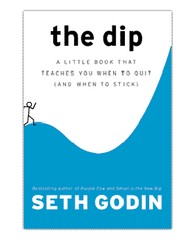

Godin then goes on to argue that winners quit fast, quit often, and quit without guilt - and they do so until they find The Right Dip to attack. If you know when to quit and when you shouldn’t, you’d have a tool for career success. What you quit and how you quit makes all the difference. Of course, Godin sets this up in order to present the book’s core message: that quitting at the dip isn’t always bad. The dip is when you’re most likely to give up. It’s when you stop making easy progress, and when your growth slows to a crawl. Seth Godin’s The Dip is a short book about a simple idea: every skill worth getting good at has a dip in the middle. But this was mine in the long drought that I experienced in Judo, I had overcome my very first dip. I'm sure many of you have had similar, foundational experiences - be it in sport, or art, or school. “You can overcome this,” I'd tell myself, “You overcame a year of losing.” I would reference my experience in Judo years into the future, whenever I had trouble with math, or computer programming, or business. Little did I know the experience would become foundational, in the best way that sports could be. When I finally began throwing people, a year later, it was a rush. But I stuck with Judo, even when I didn’t see progress for what seemed like a terribly long time. I’d tried other sports (badminton, basketball) when I was younger, and had quickly folded at both.

Was I discouraged? Of course I was! But for some unfathomable reason I found Judo fascinating, and I didn’t give up. And so for a long period, a horrible twelve months, I watched as my peers climbed in their belt rankings, while I stayed a measly beginner - a yellow belt.

It took me over a year before I began throwing anyone in competitions. I started playing Judo fairly late, at age 15.


 0 kommentar(er)
0 kommentar(er)
